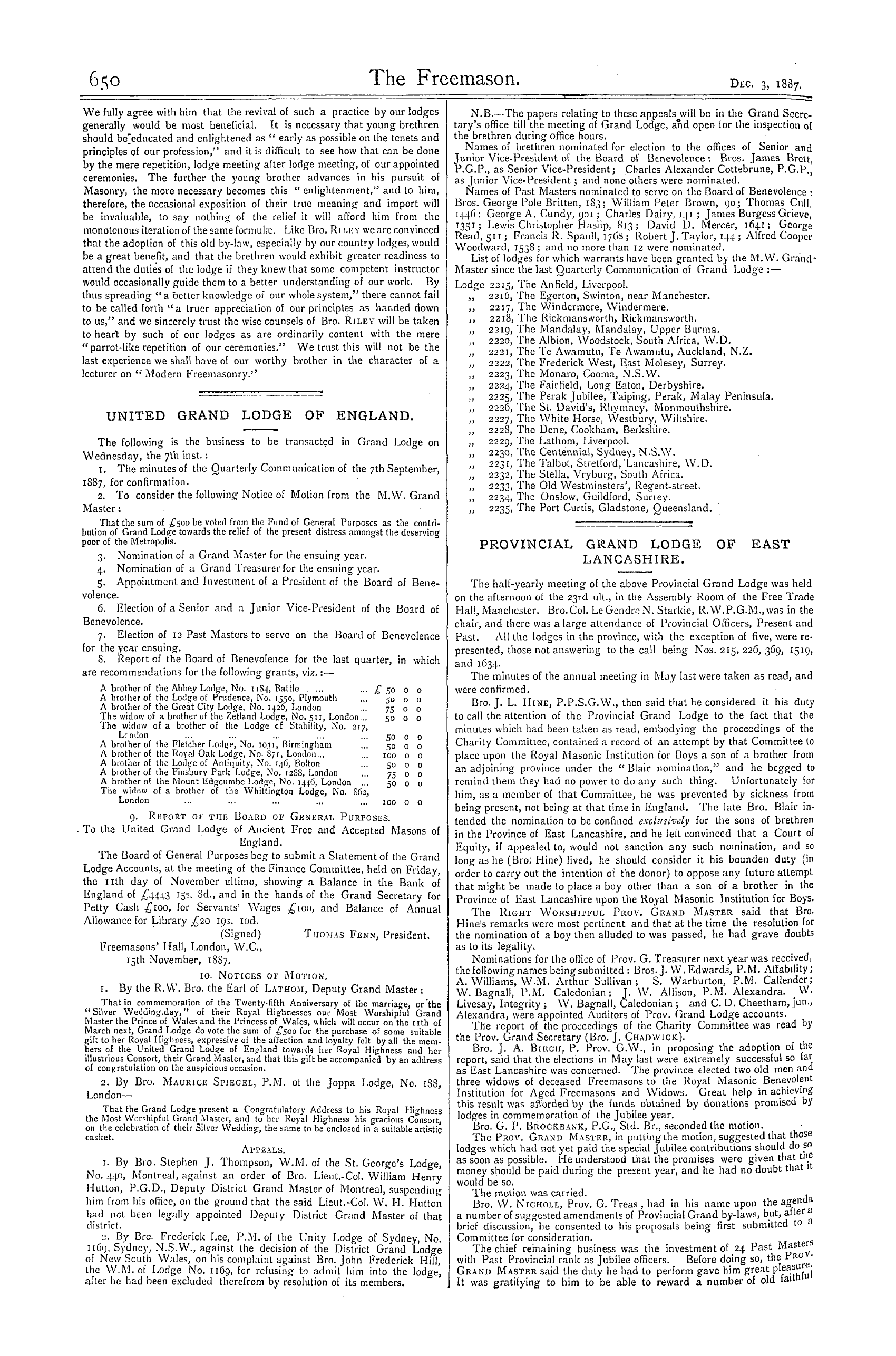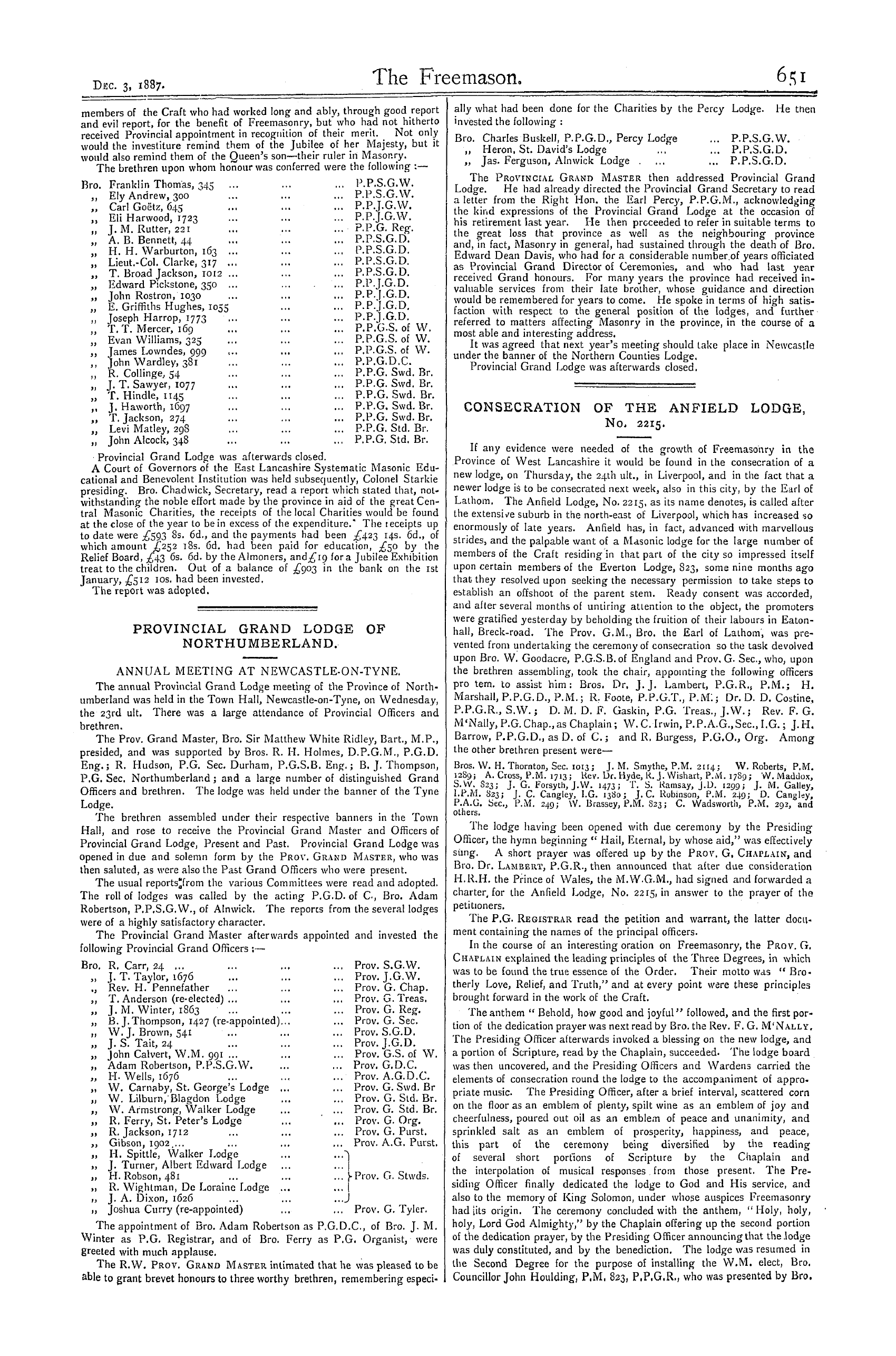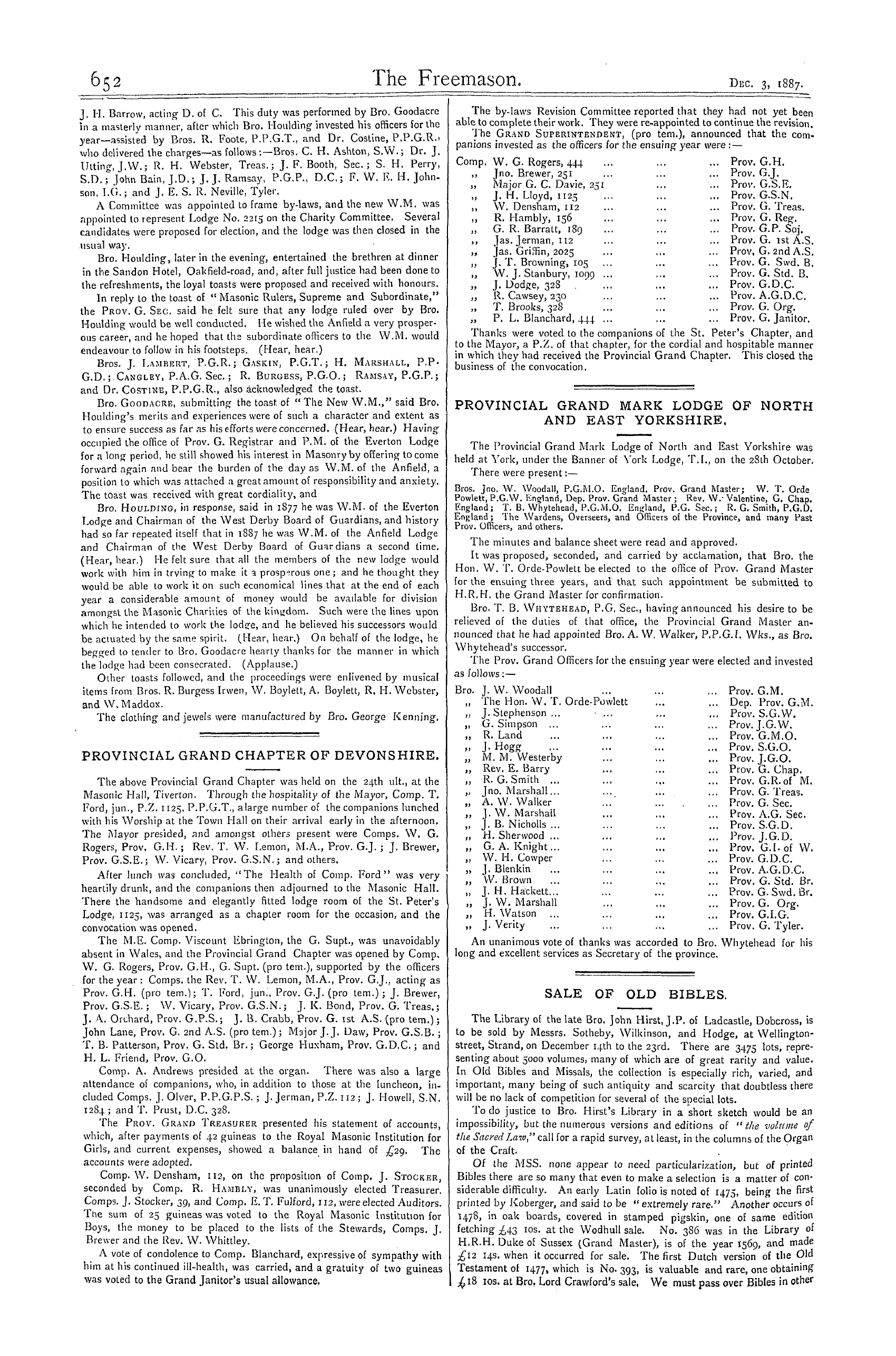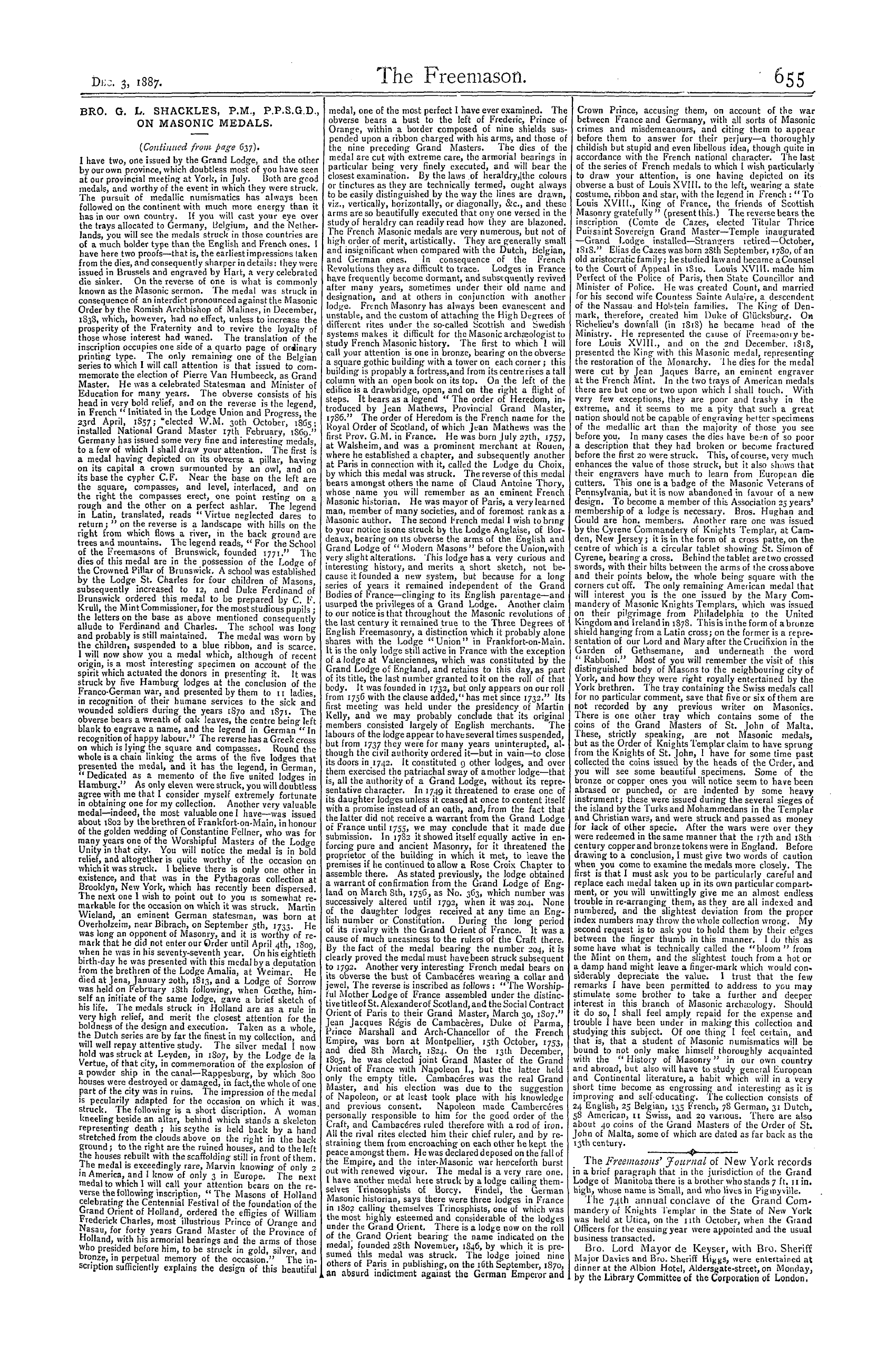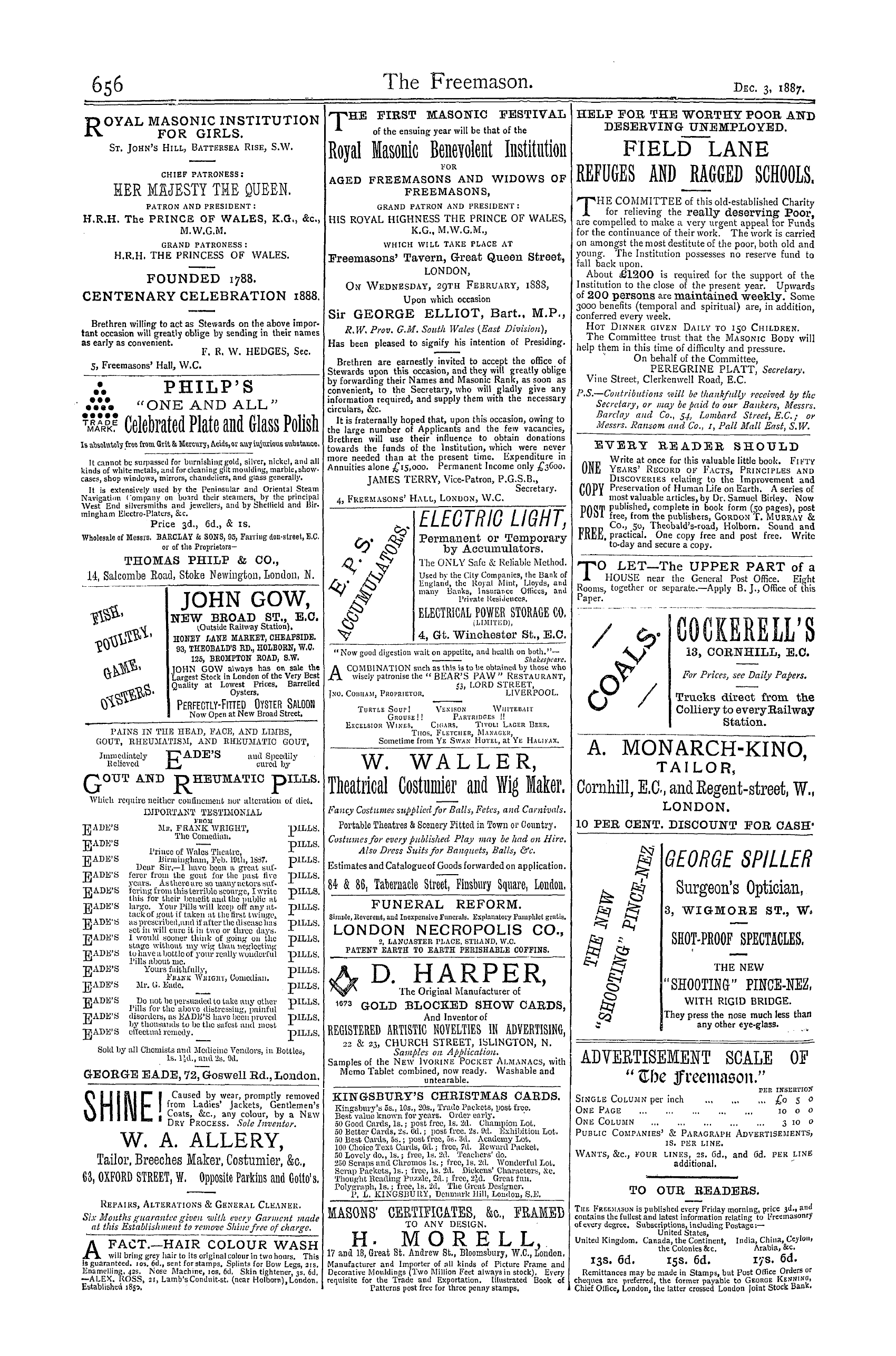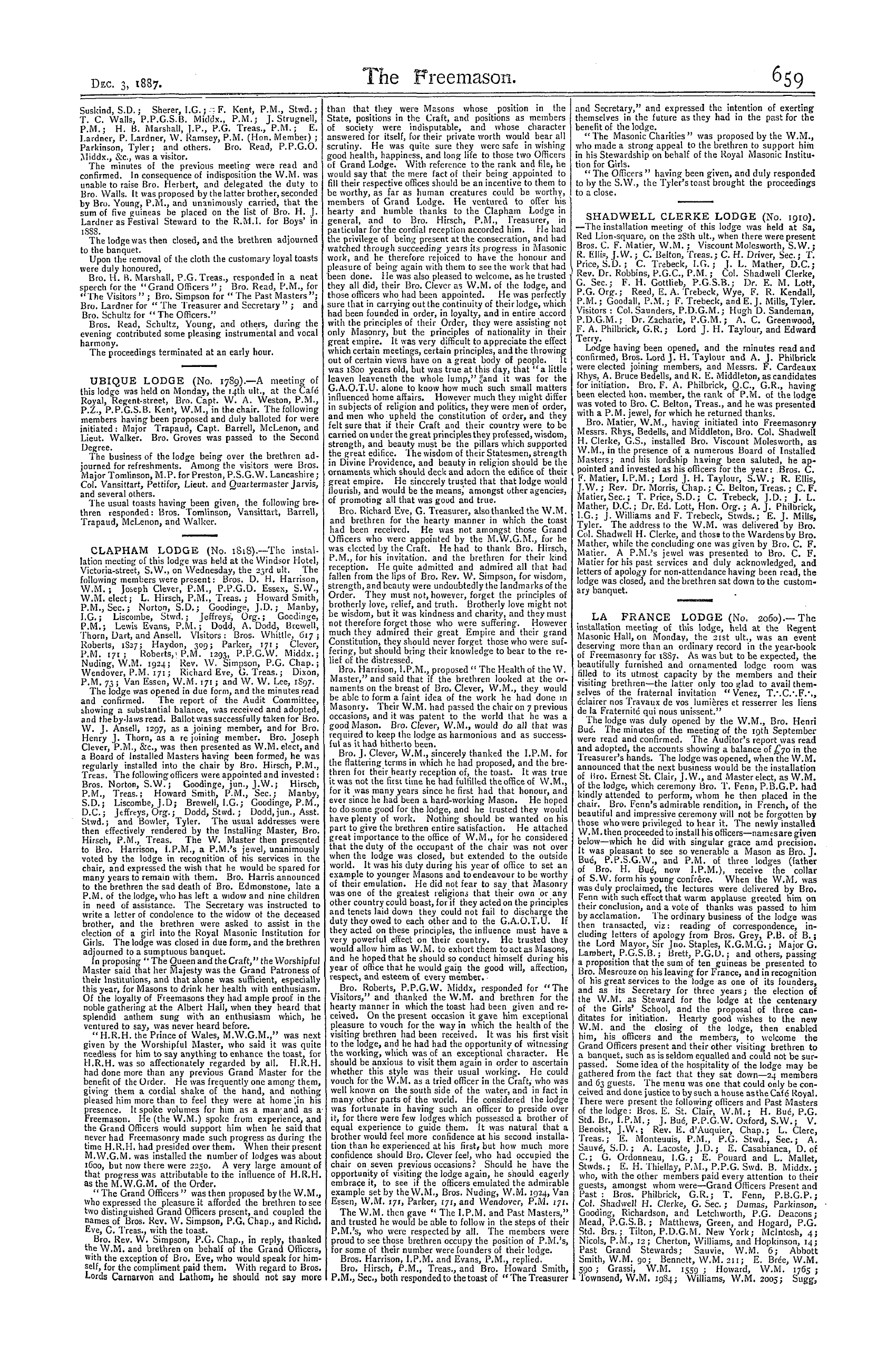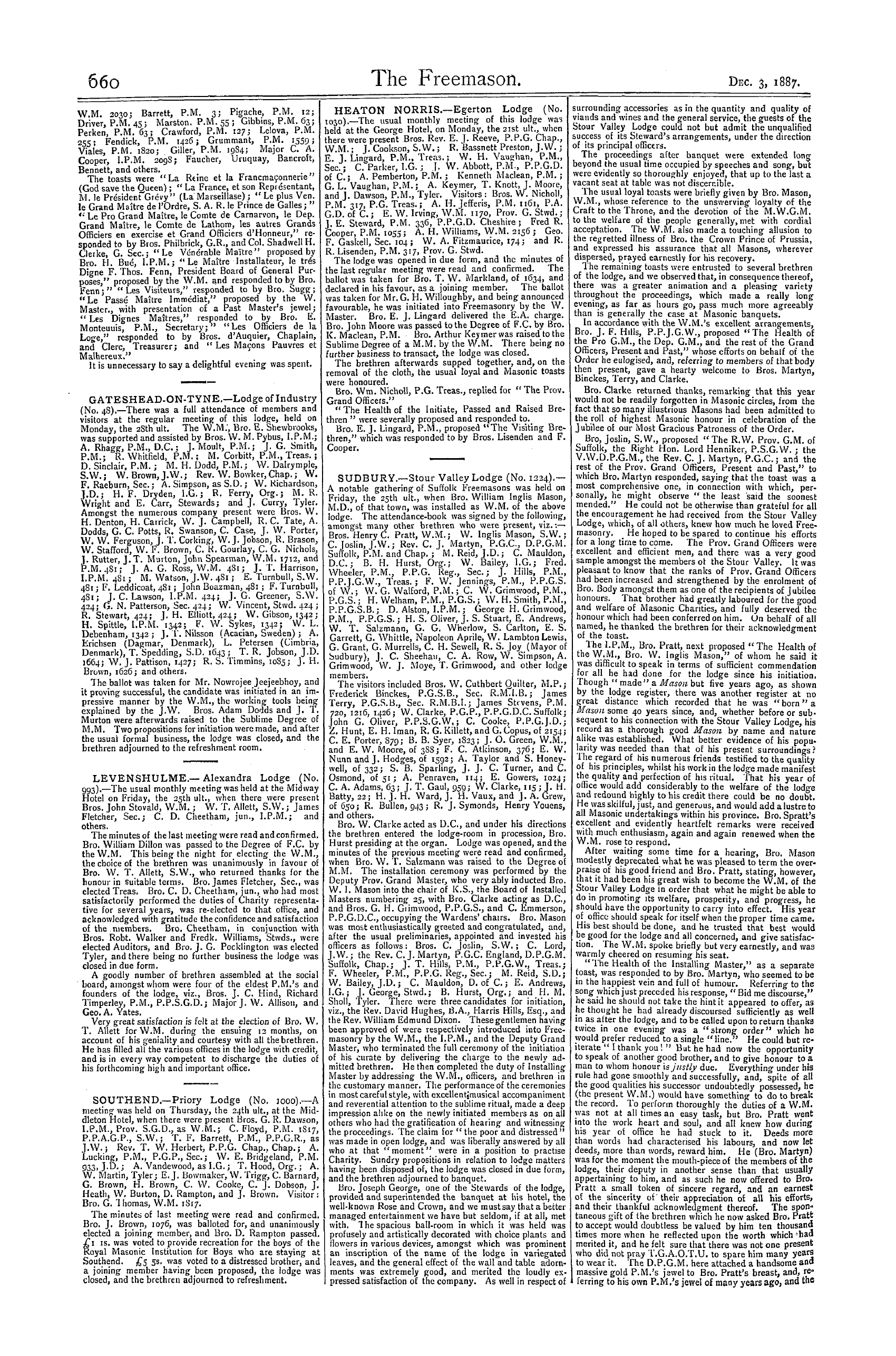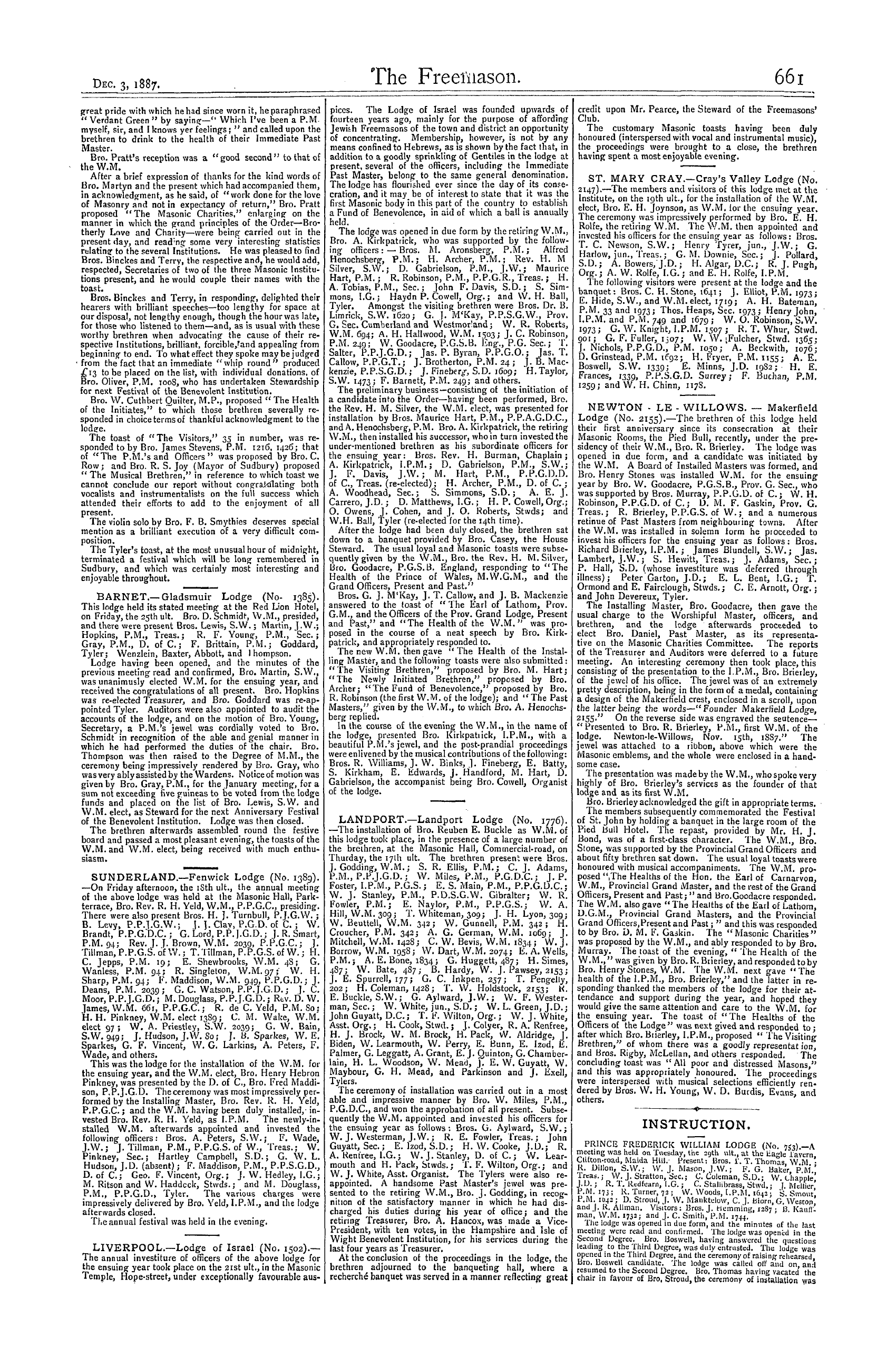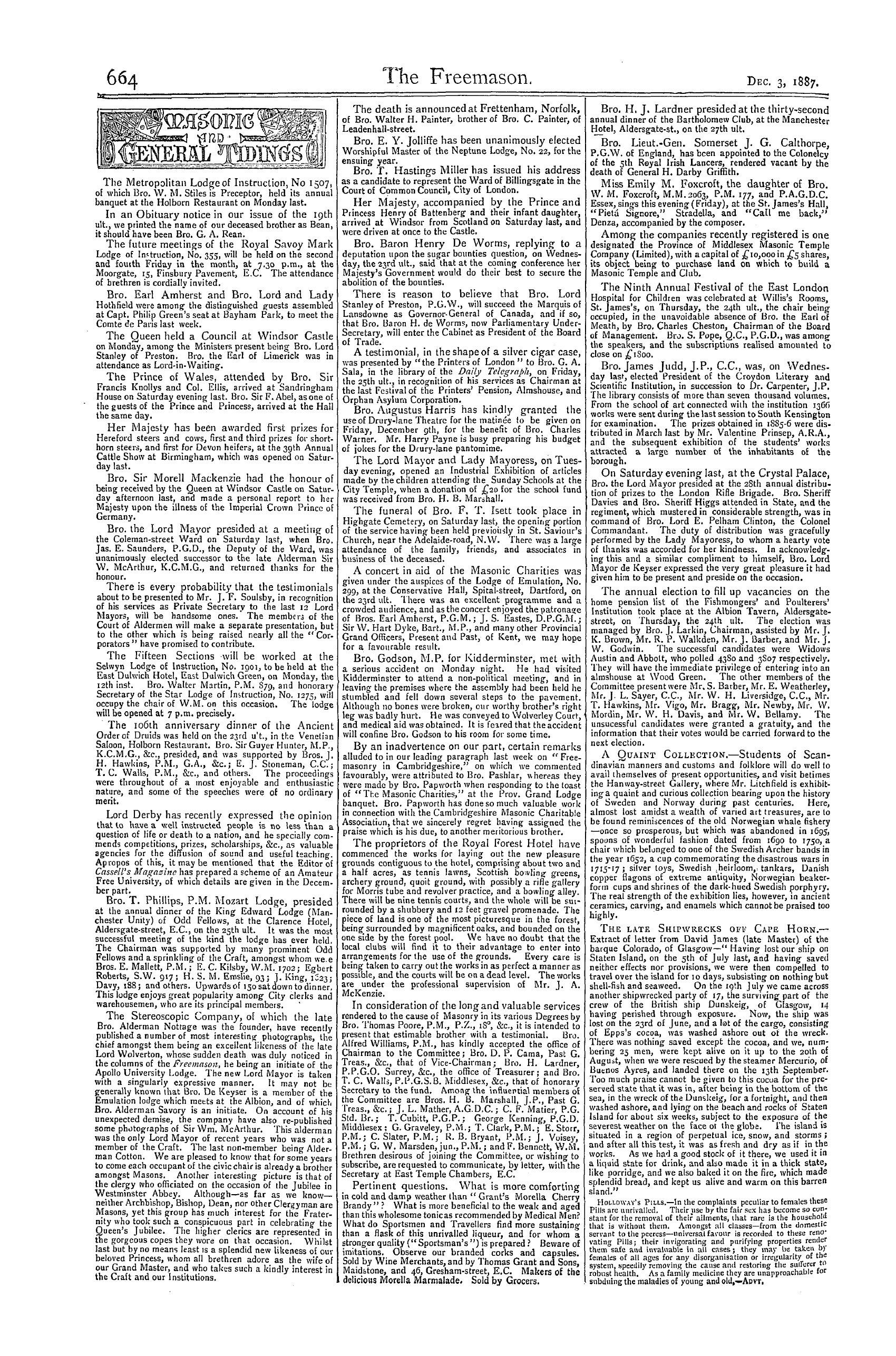-
Articles/Ads
Article To Correspondents. Page 1 of 1 Article Untitled Page 1 of 1 Article Original Correspondence. Page 1 of 1 Article Original Correspondence. Page 1 of 1 Article Reviews. Page 1 of 2 Article Reviews. Page 1 of 2 →
Note: This text has been automatically extracted via Optical Character Recognition (OCR) software.
To Correspondents.
To Correspondents .
The following * communications unavoidably stand over : CRAFT—Howard of Brotherly Love Lodge , No . 56 ; Dalhousie Lodge , No . S 65 ; Londonderry Lodge , No . 2039 . MARK—Time Immemorial Lodge , Newcastle , * and Sunderland Lodge , No . 124 .. ROVAL ARK MARINERS—Time Immemorial Lodge , NpwrnsMp .
Provincial Grand Chapter of Lincolnshire . Consecration of the Lathom Lodge , No . 2229 . Complimentary Banquet to the Mayor of Hull . BOOKS . & c , RECEIVED . "Die Bauhotte , " "Orient , " "Victorian Freemason , " "New Zealand Freemason , " " Masonic Chronicle , " " La Revista Masonica del Peru , " and "Keystone . "
Ar00905
SATURDAY , DECEMBER 3 , 1887 .
Original Correspondence.
Original Correspondence .
[ We do uot hold ourselves responsible for , or even approving o £ the opinions expressed by our correspondents , but we wish in a spirit of fair play to all to permit—within certain necessary limits—free discussion . ]
MASONIC CHARITIES . ^ To the Editor of the "Freemason . " Dear Sir and Brother , I will not prolong * this discussion further than by saying in reply to "Zeta" that if he had in the lirst instance stated what he now does , " my criticism , like 'J . 174 , ' 's table , was confined to the Festival returns" I should
, not have complained , but he made the assertion that the province he referred to ( doubtless Lincolnshire ) had given nothing to the Girls' School for the past four years ; this I have proved to be an incorrect statement . I have no doubt " Hergian " will deal with thc letter of St . Augustine , but for his information I may explain that of the boys in the School one was not the candidate of the province . I am
therefore , unable to say where the votes came from . Another was elected by votes from the two provinces with which the father was connected . This , and another of the girls , one _ was admitted without election ; a second was admitted in a similar manner in honour of the Queen's Jubilee . This does not leave many scholars to fie dealt with by the votes of the province , and my very limited
experience of elections has taught me that I can use Benevolent votes in order to increase the voting power for boys and girls ; these St . Augustine ignores . I have , I ( freely acknowledge , frequently had to borrow votes , but the loan is always repaid , and it should surely be enough to know
votes recorded , whether they are borrowed or given , represent a money purchase , and so long as the money has been given for them it can matter butAttle to those who take upon themselves the office of critics where the votes come from . —Yours fraternally , 29 th November . B . VICKERS , P . G . Sec .
THE GREAT PYRAMID AND FREEMASONRY . To the Editor of the " Freemason . " Dear Sir ,. Having by chance read in some newspapers received from Cape Colony various articles on the " Great Pyramid , " written by Dr . G . C . Cooper , I wrote to him , at the same time sending him a copy of my father ' s
lecture on " The Great Pyramid and Freemasonry . " I enclose an extract from a letter I have received from Dr . Cooper , as 1 find be is a Mason , and 1 thought bis remarks might be interesting to some of your readers . — I remain , yours truly , J . H . CHAPMAN . 54 , Winter-street , Sheffield , 7 th Nov ., 1 S 87 .
" Graaff Reinet ( South Africa ) , " Dear Sir , " August 15 th , 1887 . "I have duly received your kind note and pamphlet . It Is very curious how things work out in connection with the Great Pyramid work . I began in 1878 , after reading the ' Digest of the Pyramid Teachings . ' At once
1 said , if the Pyramid was built by inspiration , it does not and cannot stand by itself , but must be in connection with Mount Sinai and Jerusalem ; and then I began the research which has been constant from that time . I have been in the habit of putting all the foreign places as they have come to the political front to a geometrical test , and often with remarkable symbolic results : indeed , I have
been following a line , of which I have seen no notice that anyone else has been doing the same . In the course of the eight years I have had occasion to refer to all the sciences , and have discovered that each has its references symbolized in the Great Pyramid . Both Old and New Covenants are worked into the Great Pyramid measures . I mean their details are not onl y in the Sacred Volume
, but also in the joints of the Great Pyramid . "At the present moment , a piece of the MS . upon Abram ' s leaving his father ' s house and arriving at Sechem , Egypt , & c , is somewhere in England , among Pyramid friends I hope ; as yet I do not know its fate . _ " There is one great peculiarity with my working , that is , that while I make no reference to Professor Piazzi
Smyth ' s ' Life and Work' or ' Inheritance , ' I can prove his measures to be correct , as I have over and over again obtained all the prime measures of the Great Pyramid irom Israel ' s history in their migrations over the face of the earth ; the Great Pyramid , Mount Sinai , Jerusalem , Greenwich , and Tara being the main measuring stations tor the trigonometry .
Both internally and externally the Pyramid can be built without any reference to books containing its measures . The Sacred Volume contains within itself proof that both the Great P yramid and the Temple had one ? "d the same architect . Numbers formerly in the lemple have their existence in the Pyramid at the present moment . "The Masonic Book of Constitutions has a Great r yfamid fact recorded therein , and the same may be said
Original Correspondence.
of the ceremonies of the lodge . Our tools are derived from the Pyramid work , the traditions from the Temple , this latter by lapse of time replacing the Pyramid . The knowledge of this last is to be restored in these the latter days . " The interior of the lodge is strictly belonging to the Pyramid . Does Junior Warden know what meridian he
is watching i All these kind of questions have to be answered before we know what Freemasonry means . " You will see on page S of my pamphlet that 113 * 35 + 196 * 3279 = 309 * 6779- ^ - 3 = 103 * 2389 , and the East Granite is 103 * 03 high . The coffer chamber , the same 103 * 03 x 2 = 206 * 06 . The 113 * 35-7-100 = 1 * 1335 would look like a cycle completed + " 1335 or "Blessed is he that
waiteth , & c . : and is a geometrical quantity appearing several times in the work , and is a line in connection with the P . M . jewel . " The number 50 , as you are aware , is an important factor in the Pyramid , as 5 , 50 , 500 , & c , are multiples by 10 . Opponents may say that this 50 could be applied to mean anything else ; of course it might , but does it do
so ? I think not . " What is Professor Piazzi Smyth's opinion of Freemasonry in connection with the Great Pyramid at the present time—has he altered his opinion ? . . —I remain , yours truly , ( Signed ) "G . C . COOPER , P . M . SS 2 . " "To Mr . J . H . Chapman , "Midland Lodge . " 54 , Winter-street , Sheffield . "
GIRLS' SCHOOL CENTENARY HALL . To the Editor ofthe "Freemason . " Dear Sir and Brother , Some few weeks ago , anticipating a similar query to that raised by your correspondent , " Patron R . M . I . G ., " I wrote to Notes and Queries . Subjoined is the answer which appeared in the issue of 22 nd October"INQUISITOR ( 'Centenary' ) . —The word is correctly pronounced with a slight accent on the first syllable . " I am , dear Sir and Brother ,
Yours faithfully and fraternally , F . R . W . HEDGES , 29 th November . Secretary R . M . I . G . WAS DARWIN A FREEMASON ? To the Editor of the " Freemason . " Dear Sir and Brother , I shall feel very thankful to you by your kindly informing me whether the late Charles Darwin has been a member of the Craft , and if so , to mark out to me the lodge he belonged to and the date of his initiation there . Expressing to you in advance my best thanks for your kindness , —1 remain , yours fraternally ,
SIGM . SPITZER , Deputy M . of the Friendship . Vienna , 24 th November . [ Perhaps some of our readers may be able to satisfy our correspondent ' s inquiry . —ED . F . M . ]
Reviews.
Reviews .
MASONIC FACTS AND FICTIONS . By HENRV SADLER , P . M . and P . Z ., Grand Tyler and Sub-Librarian of the Grand Lodge of England . London : GEORGE KENNING , 16 , Great Oueen-street , W . C .
As we have already suggested , it is impossible to overrate the importance of the fifth chapter entitled "' The Irish Question ' Solved . " It contains the solution which Bro . badler considers himself justified in offering of the hitherto unsolved problem as to the origin of the "Ancient " Masons . In the previous chapters he had shown that the commonly received theory about their having been a body
of seceders from the 1717 Grand Lodge is untenable . But to destroy theories hitherto thought worthy of acceptance without filling up the void caused by their destruction would have been almost worse than useless , and , therefore , Bro . Sadler in this chapter has set himself the task of providing an explanation which , albeit a new one , is well supported by the evidence he has accumulated , and will go a long
way towards settling , if indeed it does not settle for good and all , this very difficult question . His view , briefly stated , is that the "Ancient" system of Masonry was imported directly into London from Ireland , by emigrant Irish Masons who had acquired their knowledge of the Craft in lodges holding under the Grand Lodge of Ireland , and who , finding on their arrival in England that the
English Grand Lodge and lodges were unwilling to receive them except as subordinate members of their own Constitution , set up for themselves lodges of their own in vvhich to practise the rites of Freemasonry . The theory is an ingenious one , but not more ingenious than it is trustworthy . It fully accounts for the differences which characterised the rival systems of "Ancient" and "Modern "
Masonry in England . It furnishes a key to the difficulty which past writers have experienced in determining who were , and whence came , those "Irish Masons" and "Irish Lodges , " so frequently referred to as being established in this country during the iSth century . And it also further explains how and why it was that the "Ancients" in England , almost from the very beginning of their organisation ,
were able to establish and maintain such friendly relations vvith the Grand Lodge of Ireland and subsequently with that of Scotland , vvith which Ireland was on terms of amity , while the "Moderns" stood almost alone in their glory . The following are the reasons vvhich Bro . Sadler presents in support of this explanation . In the first place , the great majority of the enrolled members of the early Ancient
lodges , as set forth in Morgan s Register , are evidently of Irish extraction or nationality . 1 he By-laws of lodge No . 26 , of Dublin , of vvhich Lawrence Dermott , the successor of Morgan as Grand Secretary , was a Past Master , vvereadopted by the "Ancient" Grand Committee as the Bylaws for the government of private lodges . Their Constitutions as compiled by Dermott , and designated
"Ahiman Rezon , " were mainly derived from Spratt's " Irish Constitutions , " and they had a Grand Master's Lodge established in 1759 , to which , as in the case of the Grand Master ' s Lodge in Ireland , founded in 1749 , precedence vvas assigned on the Grand Lodge Register , and in Grand Lodge itself , over all the other private lodges . Other reasons are found in the similarity of the Irish and
Reviews.
Ancient Grand seals and in the mode of affixing them to warrants , the similar systems of registering members employed by the "Ancients" and the Irish Grand Lod ge , and the issue by both of certificates in English and Latin . Bro . Sadler notes as a further reason the fact that as early as 175 S a correspondence had been established between the two bodies , and vve think he should have added , as
among the most convincing of all , that the Ancient ritual must have been in great measure derived from Ireland , for we read in the minutes of the Grand Committee meeting , at the Temple , in Shire Lane , on the 24 th June , 1752 , Bro . John Morris , W . M . No . 9 , in the chair , that" Having no Grand Master nor Grand Warden to Install , the Grand Secretary vvas Reinstall'd according to the Ancient
Custom and Manner of installing Grand Secretaries . And having gone through the Ceremony , he vvas proclaimed and saluted ascordingly . After which he repeated the vvhole ceremony of Instating Grand & c , in the manner vvhich he had learn'd from Brother Edward Spratt , Esqr ,, the celebrated Grand Secretary of Ireland . The long Recital of this solemn Ceremony gave great
satisfaction to the audience , many of which who never had an opportunity of hearing the like before . " Again on the 2 nd September , 1752 , when Mr . George Hebden , Master of No . 4 , vvas in the chair , and it had been " resolved that the " . Grand Committee shall be formed immediately into a Working Lodge of Master Masons , in order to hear a Lecture from the Grand Secretary , Laurence Dermott , "
"the lodge was opened inAncientform of Grand Lodge . and every part of Real Freemasonry was traced and explained except the Royal Arch . " Though nothing is heresaid as to the sources of Dermott's inspiration , it cannot reasonably be doubted that it was from the same " Edward Spratt , Esqr , the celebrated Grand Secretary of Ireland . " However even without this proposed addition of our own , it must
becleartoour readers that Bro . Sadler's evidences as we hava narrated them are ample to justify his " Irish " origin of the "Ancient" Masons in England . But it may possibly be urged that though these seem to be sufficient for the purpose , so far as they go , they afford no explanation of the reasons why these Irish j Masons set up an organisation of their own , when there was already a Grand
Lodge in England , with which they could easily haveamal gamated . I'he answer which Bro . Sadler furnishes to this inquiry takes the shape of an extract from the minutes of the 1717 Grand Lodge . This extract bears date the nth September , 1735 , and is as follows : — "Notice being given to the Grand Lodge that the Master and Wardens of a lodge from Ireland attended without , desiring to be admitted by virtue of a Deputation from the Lord Kingston ,
present Grand Master of Ireland . But it appearing there was no particular Recommendation from his Lordship in this affair , their request could not be complied with unless they would accept of a new Constitution . " As to this conduct on the part of the " regular" Grand Lodge , Bro . Sadler remarks that " this proceeding seems as churlish as it vvas certainly short-sighted , " and vve think he might have
gone further , and pronounced it as an arbitrary and most irregular proceeding . As he very properly points out , there was at this period no doctrine of "exclusive Masonic jurisdiction " in force anywhere , while , to make the act still more ungraceful and , indeed , indefensible , the same Lord Kingston had been Grand Master of England the year previous to his being elected for the first time Grand Master
of Ireland . At all events , such a denial of the privileges of Masonry to the Master and Wardens of the lodge constituted by Lord Kingston must have had the effect of setting their backs up and determining them to hold aloof from the Grand Lodge of England and all its belongings , even to the setting up of lodges of thek own , in which they might meet and hold Masonic communion amongst
themselves . We say this is a proper inference for Bro . Sadler to have drawn from this and his other premises , and quite justifies the theory he now promulgates for the first time , that the "Ancient" system ot Freemasonry vvas of Irish origin . It may not be possible to show how it was built up between 1735 and 175 1 , when Morgan's Register vvas begun . But certainly it is not unreasonable to assume that Irish
Masons in London and their malcontent English brothers , after enduring for some years the inconvenience of meeting only casually , would , for their own comfort sake , if not forthe furtherance of Masonic interests , take the earliest opportunity of setting up an organisation for themselves and that , when first Morgan and then Dermott appeared on the scene , they should conclude that the time for so doing had arrived .
There is , of course , something of a speculative character about this theory , but notwithstanding this defect , it commends itself to our reason because , in the first place the several facts derived from authentic sources vvhich Bro . Sadler has laid bare alter so much patient research fit in admirably with the theory , and in the next because the theory , when tested by these facts , whether taken
separately or together , stands its ground most firmly . The chapter entitled " 'Ancient' or 'Modern 1 ' 'That is the question , ' " containing , as it does , much valuable information from the minutes , from contemporary letters , and from the minutes of the Lodge of Promulgation , which has not hitherto been published , is most important , and from the new light it is calculated to throw on the "Ancient "
system and the strong basis on which it rests , is likely to cause a strong revulsion of feeling among those brethren of to-day vvho have relied mainly on Preston for their knowledge ot eighteenth century Masonry . As to when and how these terms "Ancient" and "Modern" came to be applied to the English Masonic Societies , which were distinguished by those adjuncts to their respective titles , it is
more than probable , as Bro . Sadler suggests , that when the "Ancients" applied the term "Moderns" tothe adherents of the 1717 Grand Lodge , "they were actuated more by desire of making vvhat they doubtless considered a just and necessary distinction between the two Societies than of using the words in a derogatory sense . " Some , however , may consider the word " Modern " was intended
to be used in a disparaging sense in the following extract from the minutes of a Grand Committee meeting of emergency held at the King and Queen , Cable-street , Rosemary Lane , on the 13 th July , 1753 , Bro . Hovan , W . M . 16 , being in the chair , and there being also present the Masters of Nos . 2 , 3 , 4 , 5 > < - > - . 7 > S , 9 , , 11 , 12 , 14 , 15 , 17 , iS , ig , 20 , and 22 . The subject under discussion vvas the
regulation of funerals , and we are told that in the courae of the debate "itappear'd that some persons of late had walked before the corps in immitation of a Modern Lodge who had so done . It also appear'd that the Antient Masons had formerly walked in the tollowing manner . " But there can be little doubt the word " Modern " vvas meant to be applied in this sense in the minutes of a still earlier meeting
Note: This text has been automatically extracted via Optical Character Recognition (OCR) software.
To Correspondents.
To Correspondents .
The following * communications unavoidably stand over : CRAFT—Howard of Brotherly Love Lodge , No . 56 ; Dalhousie Lodge , No . S 65 ; Londonderry Lodge , No . 2039 . MARK—Time Immemorial Lodge , Newcastle , * and Sunderland Lodge , No . 124 .. ROVAL ARK MARINERS—Time Immemorial Lodge , NpwrnsMp .
Provincial Grand Chapter of Lincolnshire . Consecration of the Lathom Lodge , No . 2229 . Complimentary Banquet to the Mayor of Hull . BOOKS . & c , RECEIVED . "Die Bauhotte , " "Orient , " "Victorian Freemason , " "New Zealand Freemason , " " Masonic Chronicle , " " La Revista Masonica del Peru , " and "Keystone . "
Ar00905
SATURDAY , DECEMBER 3 , 1887 .
Original Correspondence.
Original Correspondence .
[ We do uot hold ourselves responsible for , or even approving o £ the opinions expressed by our correspondents , but we wish in a spirit of fair play to all to permit—within certain necessary limits—free discussion . ]
MASONIC CHARITIES . ^ To the Editor of the "Freemason . " Dear Sir and Brother , I will not prolong * this discussion further than by saying in reply to "Zeta" that if he had in the lirst instance stated what he now does , " my criticism , like 'J . 174 , ' 's table , was confined to the Festival returns" I should
, not have complained , but he made the assertion that the province he referred to ( doubtless Lincolnshire ) had given nothing to the Girls' School for the past four years ; this I have proved to be an incorrect statement . I have no doubt " Hergian " will deal with thc letter of St . Augustine , but for his information I may explain that of the boys in the School one was not the candidate of the province . I am
therefore , unable to say where the votes came from . Another was elected by votes from the two provinces with which the father was connected . This , and another of the girls , one _ was admitted without election ; a second was admitted in a similar manner in honour of the Queen's Jubilee . This does not leave many scholars to fie dealt with by the votes of the province , and my very limited
experience of elections has taught me that I can use Benevolent votes in order to increase the voting power for boys and girls ; these St . Augustine ignores . I have , I ( freely acknowledge , frequently had to borrow votes , but the loan is always repaid , and it should surely be enough to know
votes recorded , whether they are borrowed or given , represent a money purchase , and so long as the money has been given for them it can matter butAttle to those who take upon themselves the office of critics where the votes come from . —Yours fraternally , 29 th November . B . VICKERS , P . G . Sec .
THE GREAT PYRAMID AND FREEMASONRY . To the Editor of the " Freemason . " Dear Sir ,. Having by chance read in some newspapers received from Cape Colony various articles on the " Great Pyramid , " written by Dr . G . C . Cooper , I wrote to him , at the same time sending him a copy of my father ' s
lecture on " The Great Pyramid and Freemasonry . " I enclose an extract from a letter I have received from Dr . Cooper , as 1 find be is a Mason , and 1 thought bis remarks might be interesting to some of your readers . — I remain , yours truly , J . H . CHAPMAN . 54 , Winter-street , Sheffield , 7 th Nov ., 1 S 87 .
" Graaff Reinet ( South Africa ) , " Dear Sir , " August 15 th , 1887 . "I have duly received your kind note and pamphlet . It Is very curious how things work out in connection with the Great Pyramid work . I began in 1878 , after reading the ' Digest of the Pyramid Teachings . ' At once
1 said , if the Pyramid was built by inspiration , it does not and cannot stand by itself , but must be in connection with Mount Sinai and Jerusalem ; and then I began the research which has been constant from that time . I have been in the habit of putting all the foreign places as they have come to the political front to a geometrical test , and often with remarkable symbolic results : indeed , I have
been following a line , of which I have seen no notice that anyone else has been doing the same . In the course of the eight years I have had occasion to refer to all the sciences , and have discovered that each has its references symbolized in the Great Pyramid . Both Old and New Covenants are worked into the Great Pyramid measures . I mean their details are not onl y in the Sacred Volume
, but also in the joints of the Great Pyramid . "At the present moment , a piece of the MS . upon Abram ' s leaving his father ' s house and arriving at Sechem , Egypt , & c , is somewhere in England , among Pyramid friends I hope ; as yet I do not know its fate . _ " There is one great peculiarity with my working , that is , that while I make no reference to Professor Piazzi
Smyth ' s ' Life and Work' or ' Inheritance , ' I can prove his measures to be correct , as I have over and over again obtained all the prime measures of the Great Pyramid irom Israel ' s history in their migrations over the face of the earth ; the Great Pyramid , Mount Sinai , Jerusalem , Greenwich , and Tara being the main measuring stations tor the trigonometry .
Both internally and externally the Pyramid can be built without any reference to books containing its measures . The Sacred Volume contains within itself proof that both the Great P yramid and the Temple had one ? "d the same architect . Numbers formerly in the lemple have their existence in the Pyramid at the present moment . "The Masonic Book of Constitutions has a Great r yfamid fact recorded therein , and the same may be said
Original Correspondence.
of the ceremonies of the lodge . Our tools are derived from the Pyramid work , the traditions from the Temple , this latter by lapse of time replacing the Pyramid . The knowledge of this last is to be restored in these the latter days . " The interior of the lodge is strictly belonging to the Pyramid . Does Junior Warden know what meridian he
is watching i All these kind of questions have to be answered before we know what Freemasonry means . " You will see on page S of my pamphlet that 113 * 35 + 196 * 3279 = 309 * 6779- ^ - 3 = 103 * 2389 , and the East Granite is 103 * 03 high . The coffer chamber , the same 103 * 03 x 2 = 206 * 06 . The 113 * 35-7-100 = 1 * 1335 would look like a cycle completed + " 1335 or "Blessed is he that
waiteth , & c . : and is a geometrical quantity appearing several times in the work , and is a line in connection with the P . M . jewel . " The number 50 , as you are aware , is an important factor in the Pyramid , as 5 , 50 , 500 , & c , are multiples by 10 . Opponents may say that this 50 could be applied to mean anything else ; of course it might , but does it do
so ? I think not . " What is Professor Piazzi Smyth's opinion of Freemasonry in connection with the Great Pyramid at the present time—has he altered his opinion ? . . —I remain , yours truly , ( Signed ) "G . C . COOPER , P . M . SS 2 . " "To Mr . J . H . Chapman , "Midland Lodge . " 54 , Winter-street , Sheffield . "
GIRLS' SCHOOL CENTENARY HALL . To the Editor ofthe "Freemason . " Dear Sir and Brother , Some few weeks ago , anticipating a similar query to that raised by your correspondent , " Patron R . M . I . G ., " I wrote to Notes and Queries . Subjoined is the answer which appeared in the issue of 22 nd October"INQUISITOR ( 'Centenary' ) . —The word is correctly pronounced with a slight accent on the first syllable . " I am , dear Sir and Brother ,
Yours faithfully and fraternally , F . R . W . HEDGES , 29 th November . Secretary R . M . I . G . WAS DARWIN A FREEMASON ? To the Editor of the " Freemason . " Dear Sir and Brother , I shall feel very thankful to you by your kindly informing me whether the late Charles Darwin has been a member of the Craft , and if so , to mark out to me the lodge he belonged to and the date of his initiation there . Expressing to you in advance my best thanks for your kindness , —1 remain , yours fraternally ,
SIGM . SPITZER , Deputy M . of the Friendship . Vienna , 24 th November . [ Perhaps some of our readers may be able to satisfy our correspondent ' s inquiry . —ED . F . M . ]
Reviews.
Reviews .
MASONIC FACTS AND FICTIONS . By HENRV SADLER , P . M . and P . Z ., Grand Tyler and Sub-Librarian of the Grand Lodge of England . London : GEORGE KENNING , 16 , Great Oueen-street , W . C .
As we have already suggested , it is impossible to overrate the importance of the fifth chapter entitled "' The Irish Question ' Solved . " It contains the solution which Bro . badler considers himself justified in offering of the hitherto unsolved problem as to the origin of the "Ancient " Masons . In the previous chapters he had shown that the commonly received theory about their having been a body
of seceders from the 1717 Grand Lodge is untenable . But to destroy theories hitherto thought worthy of acceptance without filling up the void caused by their destruction would have been almost worse than useless , and , therefore , Bro . Sadler in this chapter has set himself the task of providing an explanation which , albeit a new one , is well supported by the evidence he has accumulated , and will go a long
way towards settling , if indeed it does not settle for good and all , this very difficult question . His view , briefly stated , is that the "Ancient" system of Masonry was imported directly into London from Ireland , by emigrant Irish Masons who had acquired their knowledge of the Craft in lodges holding under the Grand Lodge of Ireland , and who , finding on their arrival in England that the
English Grand Lodge and lodges were unwilling to receive them except as subordinate members of their own Constitution , set up for themselves lodges of their own in vvhich to practise the rites of Freemasonry . The theory is an ingenious one , but not more ingenious than it is trustworthy . It fully accounts for the differences which characterised the rival systems of "Ancient" and "Modern "
Masonry in England . It furnishes a key to the difficulty which past writers have experienced in determining who were , and whence came , those "Irish Masons" and "Irish Lodges , " so frequently referred to as being established in this country during the iSth century . And it also further explains how and why it was that the "Ancients" in England , almost from the very beginning of their organisation ,
were able to establish and maintain such friendly relations vvith the Grand Lodge of Ireland and subsequently with that of Scotland , vvith which Ireland was on terms of amity , while the "Moderns" stood almost alone in their glory . The following are the reasons vvhich Bro . Sadler presents in support of this explanation . In the first place , the great majority of the enrolled members of the early Ancient
lodges , as set forth in Morgan s Register , are evidently of Irish extraction or nationality . 1 he By-laws of lodge No . 26 , of Dublin , of vvhich Lawrence Dermott , the successor of Morgan as Grand Secretary , was a Past Master , vvereadopted by the "Ancient" Grand Committee as the Bylaws for the government of private lodges . Their Constitutions as compiled by Dermott , and designated
"Ahiman Rezon , " were mainly derived from Spratt's " Irish Constitutions , " and they had a Grand Master's Lodge established in 1759 , to which , as in the case of the Grand Master ' s Lodge in Ireland , founded in 1749 , precedence vvas assigned on the Grand Lodge Register , and in Grand Lodge itself , over all the other private lodges . Other reasons are found in the similarity of the Irish and
Reviews.
Ancient Grand seals and in the mode of affixing them to warrants , the similar systems of registering members employed by the "Ancients" and the Irish Grand Lod ge , and the issue by both of certificates in English and Latin . Bro . Sadler notes as a further reason the fact that as early as 175 S a correspondence had been established between the two bodies , and vve think he should have added , as
among the most convincing of all , that the Ancient ritual must have been in great measure derived from Ireland , for we read in the minutes of the Grand Committee meeting , at the Temple , in Shire Lane , on the 24 th June , 1752 , Bro . John Morris , W . M . No . 9 , in the chair , that" Having no Grand Master nor Grand Warden to Install , the Grand Secretary vvas Reinstall'd according to the Ancient
Custom and Manner of installing Grand Secretaries . And having gone through the Ceremony , he vvas proclaimed and saluted ascordingly . After which he repeated the vvhole ceremony of Instating Grand & c , in the manner vvhich he had learn'd from Brother Edward Spratt , Esqr ,, the celebrated Grand Secretary of Ireland . The long Recital of this solemn Ceremony gave great
satisfaction to the audience , many of which who never had an opportunity of hearing the like before . " Again on the 2 nd September , 1752 , when Mr . George Hebden , Master of No . 4 , vvas in the chair , and it had been " resolved that the " . Grand Committee shall be formed immediately into a Working Lodge of Master Masons , in order to hear a Lecture from the Grand Secretary , Laurence Dermott , "
"the lodge was opened inAncientform of Grand Lodge . and every part of Real Freemasonry was traced and explained except the Royal Arch . " Though nothing is heresaid as to the sources of Dermott's inspiration , it cannot reasonably be doubted that it was from the same " Edward Spratt , Esqr , the celebrated Grand Secretary of Ireland . " However even without this proposed addition of our own , it must
becleartoour readers that Bro . Sadler's evidences as we hava narrated them are ample to justify his " Irish " origin of the "Ancient" Masons in England . But it may possibly be urged that though these seem to be sufficient for the purpose , so far as they go , they afford no explanation of the reasons why these Irish j Masons set up an organisation of their own , when there was already a Grand
Lodge in England , with which they could easily haveamal gamated . I'he answer which Bro . Sadler furnishes to this inquiry takes the shape of an extract from the minutes of the 1717 Grand Lodge . This extract bears date the nth September , 1735 , and is as follows : — "Notice being given to the Grand Lodge that the Master and Wardens of a lodge from Ireland attended without , desiring to be admitted by virtue of a Deputation from the Lord Kingston ,
present Grand Master of Ireland . But it appearing there was no particular Recommendation from his Lordship in this affair , their request could not be complied with unless they would accept of a new Constitution . " As to this conduct on the part of the " regular" Grand Lodge , Bro . Sadler remarks that " this proceeding seems as churlish as it vvas certainly short-sighted , " and vve think he might have
gone further , and pronounced it as an arbitrary and most irregular proceeding . As he very properly points out , there was at this period no doctrine of "exclusive Masonic jurisdiction " in force anywhere , while , to make the act still more ungraceful and , indeed , indefensible , the same Lord Kingston had been Grand Master of England the year previous to his being elected for the first time Grand Master
of Ireland . At all events , such a denial of the privileges of Masonry to the Master and Wardens of the lodge constituted by Lord Kingston must have had the effect of setting their backs up and determining them to hold aloof from the Grand Lodge of England and all its belongings , even to the setting up of lodges of thek own , in which they might meet and hold Masonic communion amongst
themselves . We say this is a proper inference for Bro . Sadler to have drawn from this and his other premises , and quite justifies the theory he now promulgates for the first time , that the "Ancient" system ot Freemasonry vvas of Irish origin . It may not be possible to show how it was built up between 1735 and 175 1 , when Morgan's Register vvas begun . But certainly it is not unreasonable to assume that Irish
Masons in London and their malcontent English brothers , after enduring for some years the inconvenience of meeting only casually , would , for their own comfort sake , if not forthe furtherance of Masonic interests , take the earliest opportunity of setting up an organisation for themselves and that , when first Morgan and then Dermott appeared on the scene , they should conclude that the time for so doing had arrived .
There is , of course , something of a speculative character about this theory , but notwithstanding this defect , it commends itself to our reason because , in the first place the several facts derived from authentic sources vvhich Bro . Sadler has laid bare alter so much patient research fit in admirably with the theory , and in the next because the theory , when tested by these facts , whether taken
separately or together , stands its ground most firmly . The chapter entitled " 'Ancient' or 'Modern 1 ' 'That is the question , ' " containing , as it does , much valuable information from the minutes , from contemporary letters , and from the minutes of the Lodge of Promulgation , which has not hitherto been published , is most important , and from the new light it is calculated to throw on the "Ancient "
system and the strong basis on which it rests , is likely to cause a strong revulsion of feeling among those brethren of to-day vvho have relied mainly on Preston for their knowledge ot eighteenth century Masonry . As to when and how these terms "Ancient" and "Modern" came to be applied to the English Masonic Societies , which were distinguished by those adjuncts to their respective titles , it is
more than probable , as Bro . Sadler suggests , that when the "Ancients" applied the term "Moderns" tothe adherents of the 1717 Grand Lodge , "they were actuated more by desire of making vvhat they doubtless considered a just and necessary distinction between the two Societies than of using the words in a derogatory sense . " Some , however , may consider the word " Modern " was intended
to be used in a disparaging sense in the following extract from the minutes of a Grand Committee meeting of emergency held at the King and Queen , Cable-street , Rosemary Lane , on the 13 th July , 1753 , Bro . Hovan , W . M . 16 , being in the chair , and there being also present the Masters of Nos . 2 , 3 , 4 , 5 > < - > - . 7 > S , 9 , , 11 , 12 , 14 , 15 , 17 , iS , ig , 20 , and 22 . The subject under discussion vvas the
regulation of funerals , and we are told that in the courae of the debate "itappear'd that some persons of late had walked before the corps in immitation of a Modern Lodge who had so done . It also appear'd that the Antient Masons had formerly walked in the tollowing manner . " But there can be little doubt the word " Modern " vvas meant to be applied in this sense in the minutes of a still earlier meeting

